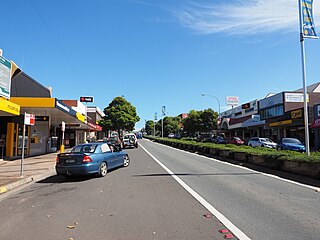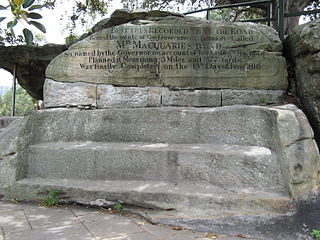Related Research Articles

Ulladulla is a coastal town in New South Wales, Australia in the City of Shoalhaven local government area. It is on the Princes Highway about 230 kilometres (140 mi) south of Sydney, halfway between Batemans Bay to the south and Nowra to the north. Ulladulla has close links with the nearby historic settlement of Milton and many services are shared between these towns.

The Australian Museum is a heritage-listed museum at 1 William Street, Sydney central business district, New South Wales, Australia. It is the oldest museum in Australia, and the fifth oldest natural history museum in the world, with an international reputation in the fields of natural history and anthropology. It was first conceived and developed along the contemporary European model of an encyclopedic warehouse of cultural and natural history and features collections of vertebrate and invertebrate zoology, as well as mineralogy, palaeontology and anthropology. Apart from exhibitions, the museum is also involved in Indigenous studies research and community programs. In the museum's early years, collecting was its main priority, and specimens were commonly traded with British and other European institutions. The scientific stature of the museum was established under the curatorship of Gerard Krefft, himself a published scientist.

Tom Iredale was an English-born ornithologist and malacologist who had a long association with Australia, where he lived for most of his life. He was an autodidact who never went to university and lacked formal training. This was reflected in his later work; he never revised his manuscripts and never used a typewriter.

Arthur Caswell Parker was an American archaeologist, historian, folklorist, museologist and noted authority on American Indian culture. Of Seneca and Scots-English descent, he was director of the Rochester Museum of Arts and Sciences from 1924 to 1945, when he developed its holdings and research into numerous disciplines for the Genesee Region. He was an honorary trustee of the New York State Historical Association. In 1935 he was elected first president of the Society for American Archaeology.

Sir Walter Baldwin Spencer, was a British-Australian evolutionary biologist, anthropologist and ethnologist. He is known for his fieldwork with Aboriginal peoples in Central Australia, contributions to the study of ethnography, and academic collaborations with Frank Gillen. Spencer introduced the study of zoology at the University of Melbourne and held the title of Emeritus Professor until his death in 1929.
Sir Cyril Fred Fox was an English archaeologist.

Mrs Macquarie's Chair is an exposed sandstone rock cut into the shape of a bench, on a peninsula in Sydney Harbour. It was hand carved by convicts in 1810, for Elizabeth Macquarie, the wife of Major-General Lachlan Macquarie, Governor of New South Wales. The peninsula itself was known to the Gadigal as Yurong Point, and is now widely known as Mrs Macquarie's Point, and is part of The Domain, near the Royal Botanic Gardens.

Carlyle Greenwell was an Australian architect whose houses, designed in the first half of the 20th century, are often heritage-listed. He was also a philanthropist who made bequests to the University of Sydney funding research in Anthropology and Archaeology.

The Museum of Archaeology and Anthropology, also known as MAA, at the University of Cambridge houses the University's collections of local antiquities, together with archaeological and ethnographic artefacts from around the world. The museum is located on the University's Downing Site, on the corner of Downing Street and Tennis Court Road. In 2013 it reopened following a major refurbishment of the exhibition galleries, with a new public entrance directly on to Downing Street.
John Otis Brew, born March 28, 1906, was an American Southwest archaeologist that not only conducted extensive archaeological research, but was also a director at the Peabody Museum at Harvard University. Many of his publications are still used today by archaeologists that conduct their work in the American Southwest. J.O. Brew was a titan in the world of archaeology for his attempts to "preserve our archaeological heritage". On March 19, 1988, John Otis Brew died from congestive heart failure in Cambridge, Massachusetts.

Burrill Lake is a small village on the Princes Highway in the South Coast region of New South Wales, Australia. It is a seaside suburb of the Milton-Ulladulla district, a part of the City of Shoalhaven local government area and surrounds the lake of the same name. In 2011, the population of the State Suburb of Burrill Lake was 1,328. The name of the town is derived from an Aboriginal word meaning 'wallaby'.

Broughton Island is an island 14 km north-east of Port Stephens, New South Wales, Australia. It is part of the Myall Lakes National Park.(map)
Charles Anderson was an Australian mineralogist and palaeontologist. He was director of the Australian Museum from 1921 to 1940.
Roscoe Hall Wilmeth was an American archaeologist who was born in St. Marys, Pennsylvania. His research was focused on the protohistoric and historic period cultures in the Southwest and Great Plains regions of the United States, and the province of British Columbia in Canada. Wilmeth's major areas of expertise included Pueblo, Navajo, Kansa, Pawnee, Athabaskan and Chilcotin cultures. Wilmeth played a major role in the creation of the state archaeologist position in Kansas, was the first to occupy this position, and later went on to become a major contributor to Canadian archaeology as an archaeologist for the Canadian Museum of Civilization, formerly known as the National Museum of Man and which includes the Archaeological Survey of Canada.

Herman F.C. ten Kate, the younger was a Dutch anthropologist. Ten Kate's anthropological knowledge gathered over several decades of travel was considered as "embryonically modern" attesting to his scientific stature. He held the view that the science of anthropology of non-Western cultures provided insight into deficiencies in Western culture. A linguist, ten Kate was fluent in eight languages. He published articles and reviews in journals; his prodigious work covered publications under 150 titles. He was a member of several expeditions, including the Hemenway Southwestern Archaeological Expedition.

Kings Point is a village in the South Coast region of New South Wales, Australia. The village forms part of the Milton Ulladulla urban area in the southern Shoalhaven. Kings Point is predominantly a residential suburb on the shores of Burrill Lake. A small light industrial area to the east separates the village from Ulladulla. At the 2016 census, Kings Point had a population of 553. The lakeside location makes Kings Point popular for fishing and water sports - the Ulladulla Water Ski Club and public boat ramp facilities allow locals and visitors to take full advantage.
Clifton Cappie Towle (1888–1946), founding member of The Anthropological Society of New South Wales in 1928 with William Walford Thorpe.

Science House is a heritage-listed commercial building located at 157–169 Gloucester Street and Essex Street, in the inner city Sydney suburb of The Rocks in the City of Sydney local government area of New South Wales, Australia. It was designed by Peddle Thorp & Walker Architects and built in 1931 by John Grant and Sons, Master Builders. It was also known as Sports House from 1978–1991. The property is owned by Property NSW, an agency of the Government of New South Wales. It was added to the New South Wales State Heritage Register on 10 May 2002.
References
- ↑ An Anecdotal History of Annandale, 'Douglas Grant (circa 1885 - 1951)'
- ↑ Australian Museum, Pioneers of Australian Archaeology
- ↑ McCarthy, F.D. 1978. New light on the Lapstone Creek excavation, Australian Archaeology , no.8, 49-60
- ↑ National Library of Australia catalogue Trove
- ↑ "Australian Anthropological Society website". Archived from the original on 5 July 2017. Retrieved 29 January 2015.
- ↑ du Cros, Hilary. "Burrill Lake Rockshelter: An early use of a research design in Australian prehistory". Australian Archaeological Association. Archived from the original on 27 June 2013. Retrieved 6 April 2013.